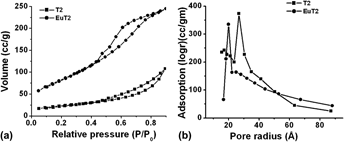Crossref Citations
This article has been cited by the following publications. This list is generated based on data provided by
Crossref.
Paul, Nibedita
Deka, Amrita
and
Mohanta, Dambarudhar
2014.
Augmented photocatalytic activity and luminescence response of Tb3+ doped nanoscale titania systems.
Journal of Applied Physics,
Vol. 116,
Issue. 14,
Liu, Qinqin
Fan, Chunya
Liu, Junxiong
Sun, Xiujuan
Cheng, Xiaonong
and
Li, Haohua
2015.
Synthesis, photocatalytic performance and negative thermal expansion property of nanorods ZrMo2−x V x O8−x/2 with cubic structure.
Journal of Sol-Gel Science and Technology,
Vol. 76,
Issue. 2,
p.
279.
Zhang, Hui
Zhang, Junli
Sun, Runjun
and
Zhou, Yingxue
2015.
Preparation of magnetic and photocatalytic cenosphere deposited with Fe3O4/SiO2/Eu-doped TiO2 core/shell nanoparticles.
Journal of Materials Research,
Vol. 30,
Issue. 23,
p.
3700.
Shiraishi, Yusuke
Takeshita, Satoru
and
Isobe, Tetsuhiko
2015.
Two Photoenergy Conversion Modes of YVO4:Eu3+ Nanoparticles: Photoluminescence and Photocatalytic Activity.
The Journal of Physical Chemistry C,
Vol. 119,
Issue. 24,
p.
13502.
Tobaldi, D. M.
Ferreira, R. A. S.
Pullar, R. C.
Seabra, M. P.
Carlos, L. D.
and
Labrincha, J. A.
2015.
Nano-titania doped with europium and neodymium showing simultaneous photoluminescent and photocatalytic behaviour.
Journal of Materials Chemistry C,
Vol. 3,
Issue. 19,
p.
4970.
Vargas Hernández, Jesús
Coste, Sandrine
García Murillo, Antonieta
Carrillo Romo, Felipe
and
Kassiba, Abdelhadi
2017.
Effects of metal doping (Cu, Ag, Eu) on the electronic and optical behavior of nanostructured TiO2.
Journal of Alloys and Compounds,
Vol. 710,
Issue. ,
p.
355.
Al-Mamun, M.R.
Kader, S.
Islam, M.S.
and
Khan, M.Z.H.
2019.
Photocatalytic activity improvement and application of UV-TiO2 photocatalysis in textile wastewater treatment: A review.
Journal of Environmental Chemical Engineering,
Vol. 7,
Issue. 5,
p.
103248.
Sarkar, Ayan
and
Khan, Gobinda Gopal
2019.
The formation and detection techniques of oxygen vacancies in titanium oxide-based nanostructures.
Nanoscale,
Vol. 11,
Issue. 8,
p.
3414.
Manurung, Posman
Situmeang, Rudy
Sinuhaji, Perdinan
and
Sembiring, Simon
2020.
Effect of Sulfur Doped Nanotitania for Degradation of Remazol Yellow and Phenol.
Asian Journal of Chemistry,
Vol. 32,
Issue. 12,
p.
3019.
Berger, Olena
2022.
Understanding the fundamentals of TiO2surfaces. Part I. The influence of defect states on the correlation between crystallographic structure, electronic structure and physical properties of single-crystal surfaces.
Surface Engineering,
Vol. 38,
Issue. 2,
p.
91.
Nur, Alam S.M.
Sultana, Marzia
Mondal, Atol
Islam, Sumon
Robel, Fataha Nur
Islam, Aminul
and
Sumi, Mst. Sumaia Aktar
2022.
A review on the development of elemental and codoped TiO2 photocatalysts for enhanced dye degradation under UV–vis irradiation.
Journal of Water Process Engineering,
Vol. 47,
Issue. ,
p.
102728.
Cerrato, Erik
Gaggero, Elisa
Calza, Paola
and
Paganini, Maria Cristina
2022.
The role of Cerium, Europium and Erbium doped TiO2 photocatalysts in water treatment: A mini-review.
Chemical Engineering Journal Advances,
Vol. 10,
Issue. ,
p.
100268.
Taghdiri, Mehdi
Mirhoseini, Hadi
Dadari Doolabi, Shahrban
and
Behjatmanesh-Ardakani, Reza
2023.
Photocatalytic degradation of dyes using phosphotungstate-hexamine hybrid under sunlight and UV irradiation: A combined experimental and DFT study.
Advances in Materials and Processing Technologies,
Vol. 9,
Issue. 4,
p.
1960.
Sultana, Marzia
Mondal, Atol
Islam, Sumon
Khatun, MOST. Afroza
Rahaman, Md. Hafezur
Chakraborty, Ashok Kumar
Rahman, Md. Shahedur
Rahman, Md Mahfuzur
and
Nur, Alam S.M.
2023.
Strategic development of metal doped TiO2 photocatalysts for enhanced dye degradation activity under UV–Vis irradiation: A review.
Current Research in Green and Sustainable Chemistry,
Vol. 7,
Issue. ,
p.
100383.
Bharatbhai Akhani, Sonal
Pathak, Jaivik
Akhani, TrilokKumar
and
Singh Rathore, Mahendra
2024.
Structural and optical properties of Mg doped TiO2 nanoparticles synthesized by sol-gel method.
Materials Today: Proceedings,
Sari, Y.
Gareso, P. L.
and
Tahir, D.
2025.
Review: influence of synthesis methods and performance of rare earth doped TiO2 photocatalysts in degrading dye effluents.
International Journal of Environmental Science and Technology,
Vol. 22,
Issue. 3,
p.
1975.
Kaya, Seydanur
2025.
Structural and mechanical modifications in Eu/Ho doped TiO2: Insights into phase transformation and strengthening mechanisms.
Materials Chemistry and Physics,
Vol. 334,
Issue. ,
p.
130437.
